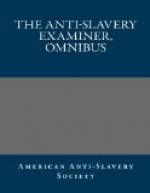This power has been conceded by grand juries of the District. The grand jury of the county of Alexandria, at the March term 1802, presented the domestic slave trade as a grievance, and said, “We consider these grievances demanding legislative redress.” Jan. 19, 1829, Mr. Alexander, of Virginia, presented a representation of the grand jury in the city of Washington, remonstrating against “any measure for the abolition of slavery within said District, unless accompanied by measures for the removal of the emancipated from the same;” thus, not only conceding the power to emancipate slaves, but affirming an additional power, that of excluding them when free. See Journal H.R. 1828-9, p. 174.
4. This power has been conceded by State Legislatures. In 1828 the Legislature of Pennsylvania instructed their Senators in Congress “to procure, if practicable, the passage of a law to abolish slavery in the District of Columbia.” Jan. 28, 1829, the House of Assembly of New York passed a resolution, that their “Senators in Congress be instructed to make every possible exertion to effect the passage of a law for the abolition of Slavery in the District of Columbia.” In February, 1837, the Senate of Massachusetts “Resolved, That Congress having exclusive legislation in the District of Columbia, possess the right to abolish slavery and the slave trade therein, and that the early exercise of such right is demanded by the enlightened sentiment of the civilized world, by the principles of the revolution, and by humanity.” The House of Representatives passed the following resolution at the same session: “Resolved, That Congress having exclusive legislation in the District of Columbia, possess the right to abolish slavery in said District, and that its exercise should only be restrained by a regard to the public good.”
November 1, 1837, the Legislature of Vermont, “Resolved, that Congress have the full power by the constitution to abolish slavery and the slave trade in the District of Columbia, and in the territories.” The Legislature of Vermont passed in substance the same resolution, at its session in 1836.
May 30, 1836, a committee of the Pennsylvania Legislature reported the following resolution: “Resolved, That Congress does possess the constitutional power, and it is expedient to abolish slavery and the slave trade within the District of Columbia.”
In January, 1836, the Legislature of South Carolina “Resolved, That we should consider the abolition of slavery in the District of Columbia as a violation of the rights of the citizens of that District derived from the implied conditions on which that territory was ceded to the General Government.” Instead of denying the constitutional power, they virtually admit its existence, by striving to smother it under an implication. In February, 1836, the Legislature of North Carolina “Resolved, That, although by the Constitution all legislative power




